New AI system that projects a point forward and measures steering accordingly, results in the car following the AI spline very well, instead of waving around as per the previous version.
A difficult problem to tackle in a non-uniform spline based AI is acceleration and deceleration, and deducing the right times to hit the gas and brakes. The problem might blow up to require entirely new AI line organization, either uniform spline sizes, vectors and curves, or corner/straight based AI lines to make the car decide dynamically when to change inputs, as the decision is always based on the upcoming corner and that can be anything really.
Being a vague problem, and also being unnecessary to make a dynamic model in a game that uses premade tracks, I ended up tackling the acceleration deceleration problem by just recording relative speeds at every nodes myself once, and then saving the values in the track metadata file. The AI then adjusts gas and brake accordingly, the results are pretty good as demonstrated in the video.
I also discovered through testing that adding a scaler to all of those values made the AI faster or slower without any loss in accuracy (up to a point. at some level the car gets too fast to make the corners). The speed points relative to each other was the determining factor in performance and not the exact speed values in a node per se. The car now adjusts speeds dynamically. This will make difficulty levels and driver performance difference much easier to design.
Now as you can see, the car is whoppingly fast around the corners, and the AI now beat my own record with the controller in lap times, and the system was deterministic enough to get accurate reproducable lap times up to a 100th of a second in lap time accuracy.
Randomness and overtaking systems should be easeir to make now by adjusting next AI node locations within a limit
&av-racer



























